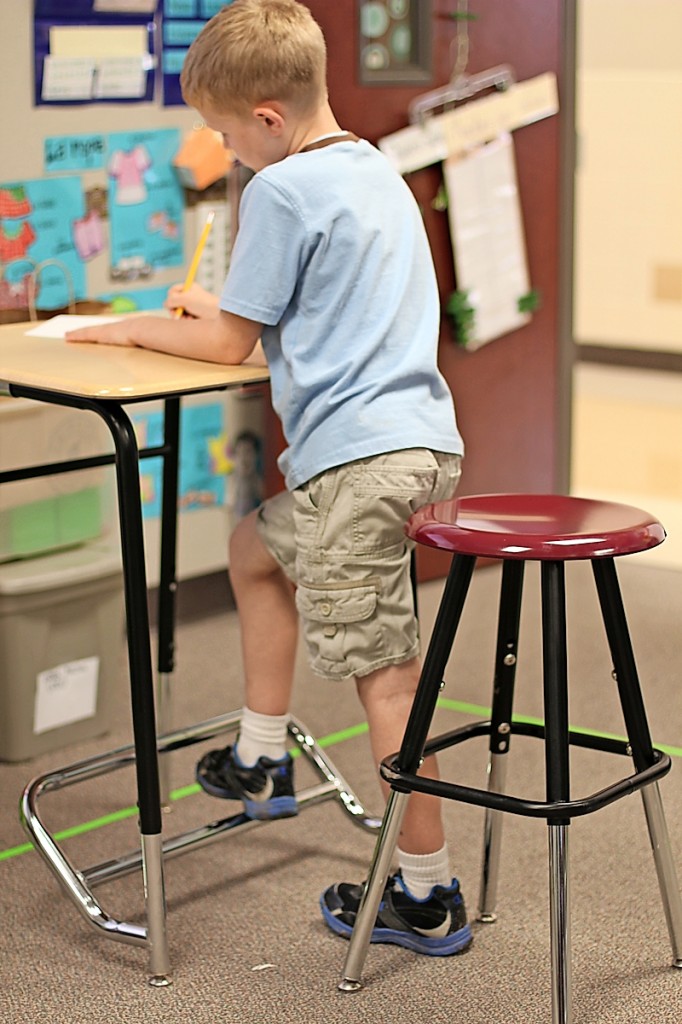Standing Room Only—How Standing Desks Can Improve Health and Give Students The Mental Edge
By Mary Kay Kleist
November 2015 View more Health & Fitness

Courtesy of Stand2Learn
Many of us know that sitting all day long isn’t good for your body or your mind. Think of how you feel after a long airplane ride or road trip—all cramped and crunched for hours. Now, imagine how our children feel after being told to “sit still” all day during school.
Experts suggest that it is possible to maintain proper spinal position while sitting, but over time, we tend to slouch, drop our heads and hunch our backs. This position compresses the diaphragm, making it more difficult to breathe efficiently. Hip flexors become short and tight from sitting too long in that kinked position. This can also create back pain. “Research shows that people who are sedentary have higher risks of obesity, heart disease, stroke, diabetes, and even some types of cancer,” said Dr. Renee Slade, Rush University Medical Center.
Standing Desks
Since we simply can’t counteract all those negatives with a daily workout or stretching routine, more and more schools are now experimenting with standing desks. Many of the desks come with a stool, so the student can stand for a period of time and then rest on the stool when they need a short break. Other desks come with a footrest.
Researchers at Texas A&M University found that children who used standing desks burned more calories than the students who sat during class. The study also showed that obese children burned even more calories while standing. Their findings are published in the International Journal of Environmental Research and Public Health, led by Mark Benden, a professor at Texas A&M University. Students were divided into two groups, a traditional sitting desk group and a standing desk group. All of the students were equipped with biometric monitors to calculate their caloric burn. The desks were created at Stand2Learn, an A&M faculty-led startup of which Benden maintains part ownership.
Joining the Movement
Several schools in Naperville School District 203 have standing desks for both students and teachers to use during the school day. One example is Elmwood Elementary. “I have found that the standing desks are a great tool for our students that tend to be more active,” said Lisa Polomsky, principal at Elmwood Elementary School. “As many educators know, movement breaks are an essential part of learning. I believe my Elmwood staff would agree with me when I say that the best learning often takes place in our classrooms when we allow students the freedom to stand, sit in a chair, sit on a bouncy ball/wobble stool and more less by just providing them with the flexibility to select what works for them while still providing them with consistent and frequent movement,” said Polomsky.
Added Benefits
Since most children naturally have the urge to fidget, standing desks can especially help children that are overweight. “Other than obesity, the other main group of children who benefit from standing desks are children with ADHD. Standing desks allow for ‘permissive fidgeting.’ By having standing desks as an option, students have the option to stand while learning without distracting classmates,” said Dr. Slade.
Most children spend about 70 percent of their day sitting. Researchers say if they move more during the daytime, they could build up their cardiovascular health, burn more calories, and reduce the risk of Type 2 diabetes. “Moving is good for the developing body. Physical activity helps develop strong bones and muscles, and being active when you are young also helps develop coordination skills. People who are active also tend to have improved brain development,” said Dr. Slade.
Even though the concept of standing desks is new, teachers, students, and parents seem to like the idea. “Just by changing the classroom furniture, we could fight obesity without adding more hours in the school day,” said Dr. Slade.


